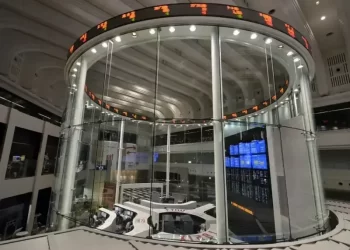Most stock markets in the Gulf reversed early losses to end higher on Thursday, ahead of key U.S. inflation data this week, while the Saudi index hit more than a five-month low.
The Qatari benchmark index rose 0.4% after dropping to its lowest in nearly four years at yesterday’s close. The index was lifted by a 4.2% increase in Qatar National Bank, the region’s largest lender, and a 4% gain in Gulf International Services.
However, for the month, the index was down 4.2%, its third straight monthly loss.
The Abu Dhabi benchmark index bounced back after eight straight sessions of losses to end 0.5% higher. First Abu Dhabi Bank, the UAE’s largest lender, climbed 1.2% and ADNOC Logistics rose 1.8%.
The energy major ADNOC’s logistics unit, ADNOC CLS, and Hanwha Ocean signed a letter of intent on Thursday to construct at least three liquefied natural gas (LNG) carriers.
Dubai’s benchmark index was up 0.3%, after two consecutive sessions of losses.
Qatar hits 4-year low as Gulf bourses drop
The blue-chip developer Emaar Properties advanced 1.9% and Emirates NBD, the emirates’ largest lender, rose 1.6%.
Saudi Arabia’s benchmark stock index dropped 1.7% to 11,503, its lowest in more than 5 months with all of its constituents posting losses. For the month, it was down 7.2%, its biggest monthly decline since September 2022.
Saudi National Bank, the kingdom’s largest lender, slipped 3% and ACWA Power slumped 10%, the steepest percentage fall in more than two years.
Meanwhile, investors are awaiting U.S. inflation data on Friday to gauge the scale of interest rate cuts this year, with markets currently pricing just one rate cut from the Federal Reserve by the end of 2024.
Most Gulf currencies are pegged to the dollar, and any U.S. monetary policy change is usually followed by Saudi Arabia, the United Arab Emirates and Qatar.









